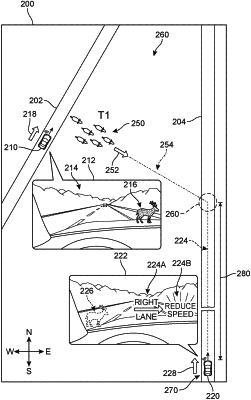| CPC B60W 50/14 (2013.01) [G08G 1/096791 (2013.01); G08G 1/161 (2013.01); B60W 2050/143 (2013.01); B60W 2050/146 (2013.01); B60W 2554/402 (2020.02); B60W 2554/404 (2020.02); H04W 4/46 (2018.02)] | 20 Claims |

|
1. A computer-implemented method of intelligently generating alerts to a driver of a first vehicle, the method comprising:
receiving, from a second vehicle and at a first time, first information about a dynamic obstacle assigned a first classification type present in an environment outside of the second vehicle around the first time;
receiving, from a third vehicle around the first time, second information about the obstacle present in an environment outside of the third vehicle around the first time;
determining, based on the first information and the second information, a first predicted path of the obstacle;
receiving a first current location and a first current route of the first vehicle;
determining, based at least on the first current location and first current route of the first vehicle and the first predicted path of the obstacle, that there is a first likelihood of a vehicle obstacle intersection event occurring between the first vehicle and the obstacle within a first period of time; and
causing, in response to the determination of the first likelihood of a vehicle obstacle intersection event occurring, a visual indicator alerting the driver about the obstacle to appear on an augmented reality (AR)-enabled display of the first vehicle, the visual indicator having a shape representing the first classification type.
|